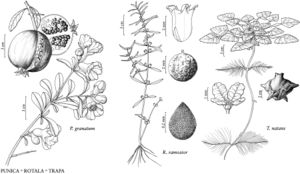Punica
Sp. Pl. 1: 472. 1753.
| Taxon | Illustrator ⠉ | |
|---|---|---|
 | Punica granatum Rotala ramosior Trapa natans |
Shrubs or small trees, terrestrial, 20–60 dm, glabrous throughout. Stems erect, much-branched, branches often terminating as indurate thorns. Leaves opposite to subopposite; subsessile to shortly petiolate; blade oblong to lanceolate-elliptic, base rounded to attenuate, apex often developing foliar nectary. Inflorescences determinate, usually terminal, sometimes axillary, in 1–5 clusters, racemes. Flowers sessile, actinomorphic, monostylous; floral-tube semi-epigynous to epigynous, usually red, sometimes yellow, campanulate or urceolate-campanulate, thick, leathery, slightly constricted medially; epicalyx segments absent; sepals 5–8, erect to recurved, 1/4–1/3 floral-tube length; petals deciduous, 5–8, usually bright red, white, or variegated, sometimes yellow, showy, crumpled; nectariferous tissue present at ovary-floral tube junction; stamens many, covering inner surface of floral-tube distal to ovary; ovary semi or fully inferior, carpels in 2 (or 3) superposed, twisted layers [in 1 regular whorl]; placenta elongate; style slender; stigma capitate. Fruits berries, crowned by persistent sepals and stamens, walls thick and leathery, indehiscent, splitting irregularly. Seeds ca. 100–1400, reddish purple, oblong-pyramidal, outer layer fleshy, inner layer hardened; cotyledons rolled.
Distribution
Introduced; Europe, Asia (India), Asia (Iran), Asia (Middle East), Africa, introduced also in warmer regions of the New World and Old World
Discussion
Species 2 (1 in the flora).
Punica protopunica Balfour f. is known only from the Indian Ocean island of Socotra in Yemen.
Selected References
None.
Lower Taxa
"dm" is not declared as a valid unit of measurement for this property."dm" is not declared as a valid unit of measurement for this property.